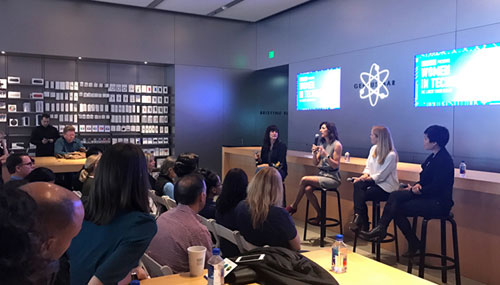Insights
Women in Tech: Diversity and Inclusion for Higher Success
By Melody Yuan

More women are venturing into the tech field and empowering themselves through technology.
Women make up more than 50 percent of the U.S. population and 59 percent of the U.S. labor force. So why is it that only 30 percent of women actively work in the technology industry? Women in leadership or technical roles show an even more significant drop in representation, showing that gender diversity and the influence of women are low in an industry with profound impact on consumers’ lives. Could tech companies potentially be missing out on 50 percent of their consumer market?
Nicole Jiao, a financial advisor specialized in the tech sector at East West Bank shares an optimistic outlook. “Female presence has been growing in both entrepreneurship and investment sides over the past two years,” she says. “You now see more women at hackathon events and technology summits, partially because of joint efforts from both the tech industry and education sector.”
While the industry acknowledges that more female representation is necessary, what more can be done to encourage inclusivity? A few women in positions of leadership share some of their experiences and insights in working in the tech industry.
Biggest obstacles for women in technology
“Imagine being assessed by the clothes you wear, and not the skills or ideas you bring to the table,” says Renee LaBran, senior advisor for Idealab, a tech incubator in Pasadena, Calif. As one of the first women who trail-blazed a career in technology, LaBran recalls the time she was given negative feedback in one of her first performance reviews because of her colorful work attire. Even after becoming a business partner with a management consulting firm, she would often arrive to meetings with her male counterparts, only to be assumed that she was an administrative assistant. “Sometimes you have to call people out for this type of behavior,” says LaBran. “These are things that men have to be aware of and women have to be willing to point out—you have to stand up for yourself, even if it’s uncomfortable.”
For Natalie Sun, a creative technologist at Next Art, her obstacles are twofold—external and internal. “I think I struggled with being a minority of a minority, and by that I mean that I am a woman of color working on technology at an advertising agency,” says Sun. “I’m a real unicorn.” Given her situation, finding good role models was difficult, as there were none in close proximity in her line of work. “A lot of my role models came from the internet—I’d look for artists who would be working on the same thing and ask for advice.” For Sun, their support was immensely helpful, and she believes that extending a hand to help others mold their own identity and place in the tech industry is important. Furthermore, as an introvert, Sun’s internal obstacle involved finding ways to actively assert herself in meetings dominated by men. “My immediate reaction as an introvert would be to walk into the room, see the table, and automatically want to sit in a corner to the side,” says Sun. “So actually grabbing a chair at the table and participating at the head of the conversation took a lot of effort.”
Max Powers, senior vice president of business operations at TeleSign, believes that social language often serves as an obstacle. “Whenever you hear someone say, ‘I have a question,’ or ‘I just wanted to say,’ it’s usually coming from a woman. When men have a question, they just go ahead and say it,” says Powers. According to the Harvard Business Review, oftentimes women shoulder the bulk of collaborative work and spend time attempting to raise others rather than to raise themselves. While men were 36 percent more likely to share knowledge and expertise, women were 66 percent more likely to assist others in need. This discrepancy is important to note, as collaborative work usually takes more time, effort, and tends to receive less recognition. “Men always feel expert and confident,” continues Powers. “But we as women tend to second guess ourselves and think of the one thing that we’re unsure about.”
From a financial perspective, Jiao says that “it is generally more difficult for female founders to receive funding from traditional venture capitalists, which are still dominated by males.” In general, only seven percent of partners at the top 100 venture firms are women. “Fortunately, more female-focused ventures are emerging these days,” says Jiao. “The companies these ventures typically invest in are founded by women, mothers and wives, creating a strong investment community that better understands the needs and concerns of women.”

"There are plenty of women who are great candidates, and I urge people to make a very conscious decision when hiring."
Adding to the competitive edge
Women, and diversity in general, make a business more competitive simply by having an amalgamation of different perspectives. The process of addressing and finding solutions to problems becomes more creative, giving businesses a competitive edge in the marketplace. “One of the things that I love about tech right now is that there’s just so much going on and so many ways to approach problems,” says LaBran. “The collaborative nature of women also adds to higher group productivity and company morale.” Studies show that the number of women consuming technology is colossal:
- 70 to 80 percent of all consumer purchasing power comes from women
- Women generate 58 percent of e-commerce dollars and spend 30 percent more time on social media
- Almost one-third of women identify as early adopters who are willing to purchase and test new technologies.
In short, beta testing for products and services would be much more effective with representation of various demographics from within your own company.
“I think that the lack of female representation is a very systemic problem that comes from a lot of different places,” says Sun. “The most important thing that women can continue to do is to remain vigilant and be more assertive participants in the industry.”
Recruiting and retaining more diversity
For Powers, the energy and fast paced environment of problem solving drew her into technology. “The industry is constantly changing and requires you to stay on top of it, and it’s crazy,” says Powers. “It’s chaos all the time.” She mentions that while this type of entrepreneurial energy is something that she fell in love with, it’s also not for everyone. “Now when I hire, I look for the types of people who are going to thrive in a chaotic environment.” LaBran believes that there are small things that people can do to level the playing field and make more accurate hiring decisions based on credentials. One example that she gives is for hiring managers to remove the names of new hires before reading their resumes. “There is plenty of evidence that supports how people hire based on unconscious biases,” says LaBran. “View the resumes in comparison to one another, and you’ll do a better job at evaluating new hires.” Sun echoes LaBran’s sentiments by stressing the need for hiring managers to look beyond the superficial level of compatibility and culture. “Culture is now something very trendy to talk about, but what I want to point out is that more people hire men based on potential, while women are hired based on what their resume shows,” says Sun. “There are plenty of women who are great candidates, and I urge people to make a very conscious decision when hiring.”
Powers adds that recruiting a more diverse pool of candidates involves talking publicly about company values and the culture that may resonate with them. “Talking about women participation is a big step. Talking about equal pay and being upfront about it is also big. Having a great benefits package that includes great maternity leave. All of these things speak about how much the company values diversity and what’s important to this demographic,” says Powers. In essence, to recruit and retain the most competitive and diverse talent, you have to put your money where your mouth is, and invest in the personal development of employees.
Subscribe to the Reach Further Newsletter
Get inspiring stories in your inbox every month.

